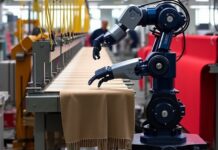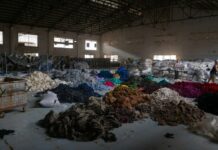In the 1970s, the Upstate region of South Carolina was renowned as the textile capital of the world. During that time, individuals would endure long summer shifts at the numerous mills located in Union, their hometown. Trains thundered through the area, carrying materials across the nation, while towering chimney stacks of the red-brick mills loomed like flagpoles. This was the heart of the textile industry, with Union, Spartanburg, and Greenville at its core.
However, by the late 1990s, the textile industry decline in South Carolina began to take its toll as automation and cheaper labor abroad shifted manufacturing away from the state. As a result, the economy in Union and much of the region plummeted. In a recent conversation, a retired worker reflected on the notion of reviving American manufacturing through tariffs, expressing skepticism about the appeal of returning to mill work, which offered low pay and limited opportunities for advancement.
The textile sector is largely regarded as a thing of the past, and many residents believe that the textile industry decline in South Carolina has left a lasting impact on their communities. The notion of restoring it is met with doubts, especially considering that many younger individuals might not find such jobs appealing anymore.
Since taking office, tariffs on imports have been imposed and suspended rapidly, aiming to encourage companies to relocate manufacturing to the United States. Recently, these tariffs were paused for a three-month period on some of America’s largest trading partners, reducing rates to a general 10%, while significantly increasing tariffs on Chinese exports.
However, the aspirations behind these tariffs collide with the current economic landscape in areas like Spartanburg and Greenville, which have transformed into prosperous industrial centers thanks to foreign investment. Local residents express concern that reinstating these tariffs could jeopardize the very businesses that have revitalized the region, home to about 1.5 million people, all in an attempt to revive an industry that few desire to see return. The ongoing textile industry decline in South Carolina serves as a reminder of the challenges faced by those communities.
Many individuals still recall the challenges of working in textile mills, which carried a negative stigma. Former workers often returned home covered in cotton fibers, and some developed serious respiratory issues due to exposure to fabric dust. The idea of their children pursuing similar jobs is not appealing to many.
Today, companies like BMW and Michelin, hailing from Germany and France, have become key players in the local economy. Since BMW established its facility in Spartanburg County in the early 1990s, the company has invested over $14.8 billion in its South Carolina operations. The plant now employs more than 11,000 people and is the largest single production facility for BMW globally, contributing significantly to the nation’s car exports.
Recently, there was surprise within the local business community when a trade advisor criticized BMW’s manufacturing model, suggesting that it was detrimental to American economics and national security. This statement raised questions among residents regarding the implications of such remarks on the established manufacturing landscape.
In defense of BMW and its contributions, local leaders pointed out that the company has attracted other businesses to the region, reinforcing South Carolina’s reputation as a strong manufacturing state. The leadership has also shown support for tariffs, acknowledging the goal of increasing self-sufficiency in the manufacturing sector.
Business leaders believe that the region’s success stems from South Carolina’s strong anti-union policies and a workforce experienced in manufacturing. However, there are concerns that engaging in a trade war could hinder future international investments and threaten existing local jobs.
If product prices rise due to tariffs and BMW experiences a significant drop in sales, the likelihood of layoffs at their Spartanburg facility increases. The potential for a revitalized textile industry to fill any gaps left behind seems remote, particularly given the low-cost fabric production in countries like Vietnam, Cambodia, and China.
Despite retaining a small textile presence in the region, current textile companies primarily focus on specialized products, such as fire-retardant fabrics. There are also developments in manufacturing that do not fit the traditional definition of the textile industry; for example, a local company produces surgical sutures, which are not categorized as textiles despite being made from thread.
While some residents express interest in a modern textile industry, they envision a more advanced and automated sector. The potential for improved working conditions and better pay could appeal to young people who are not inclined to pursue higher education.
Though there is hope that a revival in the textile sector could benefit the local economy, it is important to consider that establishing new mills would still depend on importing materials from abroad, which would be subject to tariffs and could raise costs.
For many, the complexities of tariffs and their implications for the manufacturing landscape remain confusing. As individuals reflect on their past experiences in mills, the consensus among many is that returning to those conditions is not desirable. Instead, there is a desire for future generations to pursue careers that allow them to thrive, rather than revert to outdated practices. Ultimately, the textile industry decline in South Carolina has shaped the region’s identity and economic future in profound ways.



































